You’ve probably seen pictures of Arnold Schwarzenegger performing the upright row with his shoulders popping out of his sleeves. This traditional movement has been used for decades to build the shoulders and upper back.
But, many lifters see this movement as problematic or an injury risk.
So, is the upright row a dangerous exercise? How do you avoid injury, and what are the alternatives? We cover everything you need to know in the article below.
Jump to:
What Is the Upright Row?
The Upright Row is a popular strength training exercise, primarily targeting the upper body, like the upper back and shoulder muscles. It’s a compound exercise that uses multiple joints and muscle groups, making it an effective exercise for developing upper body strength.
The movement looks simple—stand straight and lift the weight to your upper chest, keeping it close to your body.
Unfortunately, the upright row might not be suitable for all lifters. Incorrect form can place the shoulder joint in a risky position and increase the risk of injury. Individuals with pre-existing neck or shoulder injuries may also experience additional discomfort.
But with the correct form, the upright row can enhance posture and shoulder mobility and help you build upper back strength and muscle mass.
Muscles Worked
With proper form, the upright row can be an incredible exercise to incorporate into your training program for developing muscle mass in the traps, shoulders, biceps, upper back, and other secondary muscles.
Trapezius Muscles
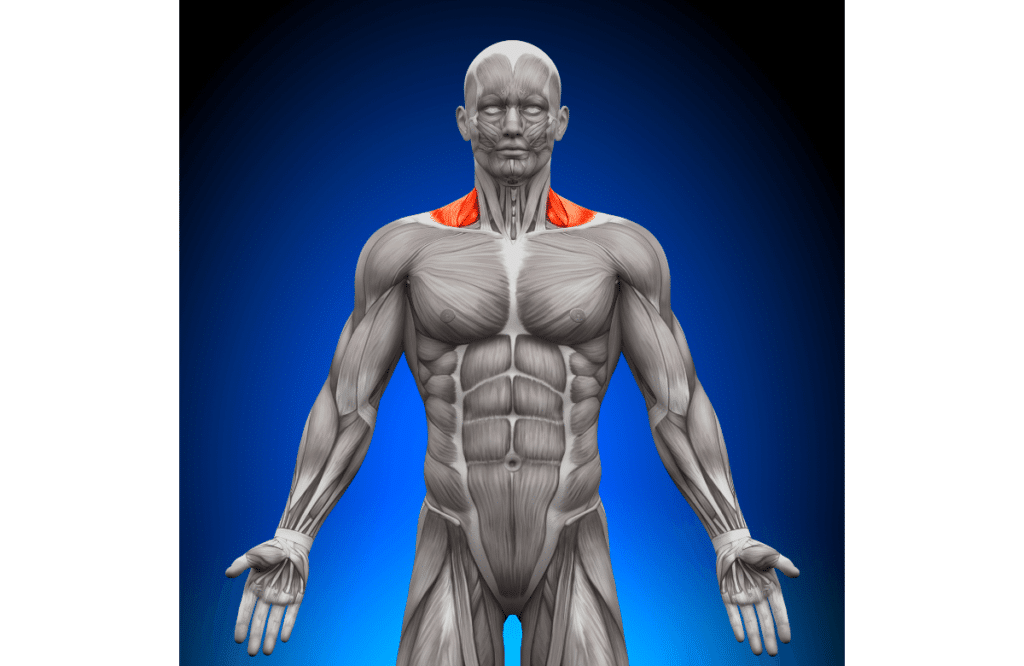
The trapezius or trap muscles on the upper back and neck are heavily involved in the upright row exercise. The upper traps help you pull the weight up during the lift, allowing you to retract the shoulder blades, providing stability and support.
Deltoid Muscles
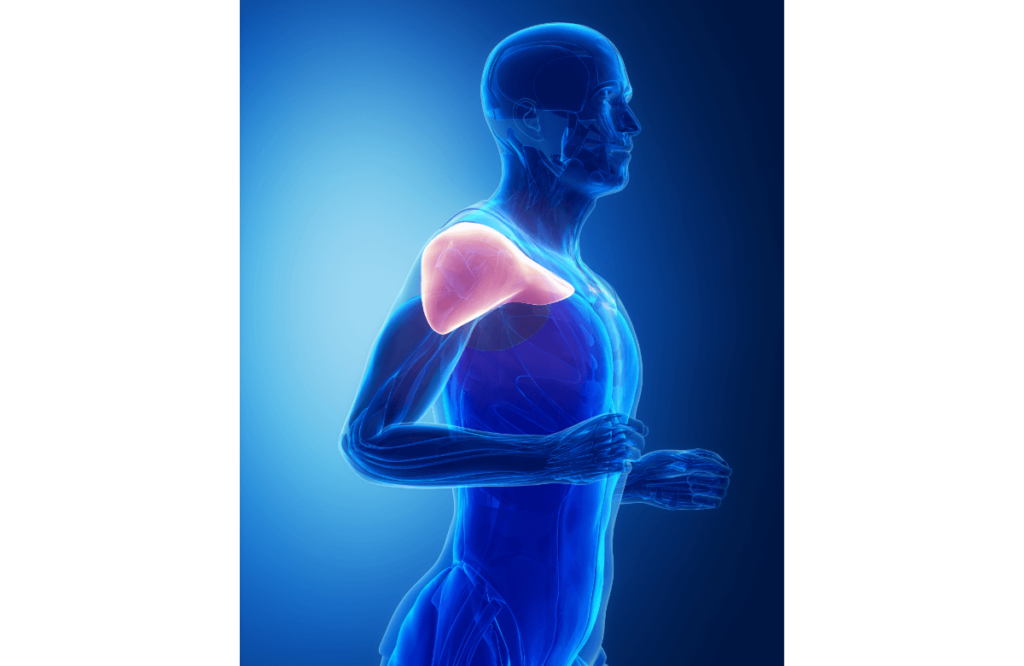
The deltoid muscles located in the shoulder are the primary focus of the upright row exercise.
The deltoids are composed of three muscle heads:
- Front or anterior deltoids
- Side or lateral deltoids
- Posterior or rear deltoids
All three deltoid heads are activated when you pull the barbell toward chest height. The movement mainly targets the front and lateral delts, with the posterior deltoid acting as a stabilizer.
Biceps Muscles
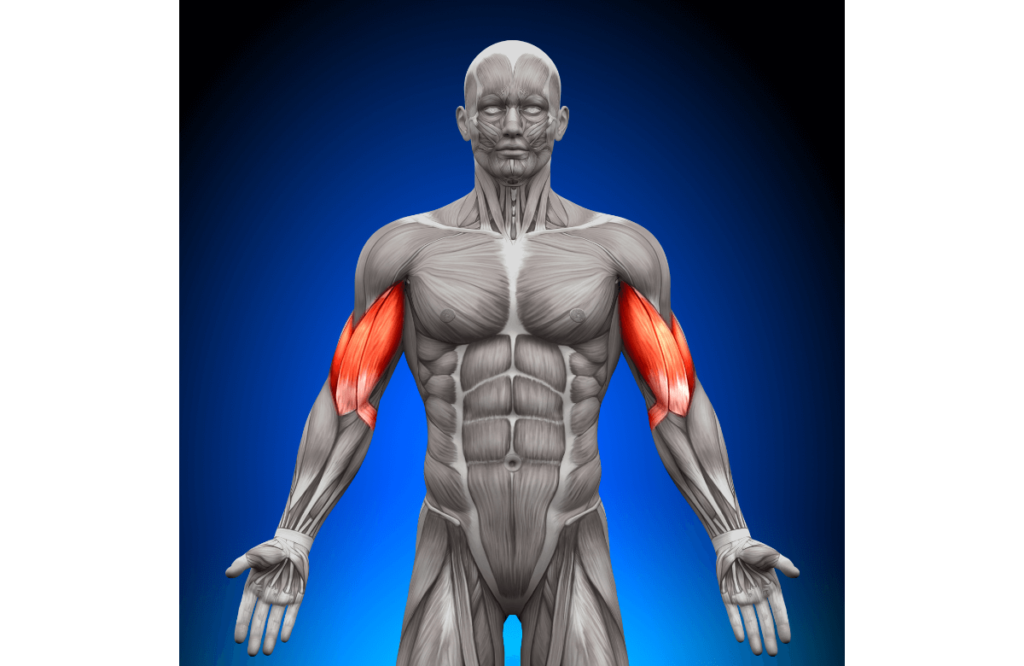
The biceps brachii, or biceps, are found on the front of the arm and engage during the fast bending motion of the compound lift. While the primary function of the biceps is elbow flexion, they also assist in shoulder flexion during the upright row. The biceps engage to a lesser extent compared to the other muscles listed.
Upper Back Muscles
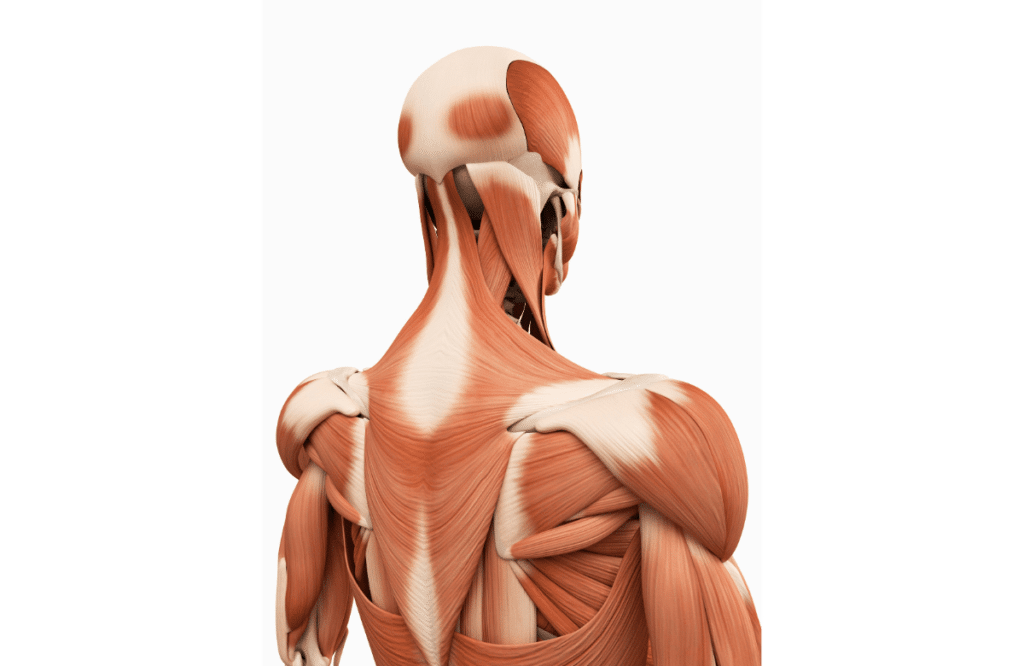
The rhomboids are situated between the shoulder blades and play a crucial role in scapular retraction. When you squeeze the shoulder blades together during the compound movement, the rhomboids engage in enhancing posture and stability.
Besides the rhomboids, the erector spinae muscles also play a role in the lift. The muscles are located along the spine, providing you with stability in the spine and lower back.
Core Muscles
Although they’re a secondary muscle, the core is also activated during the upright row.
The core allows you to keep an upright torso, acting as a foundation for the lift. The core muscles help keep the torso stationary, ensuring the correct muscles are used.
The Benefits of Upright Rows
The barbell upright row is a staple exercise in many upper-body workouts. The correct form can lead to muscle growth in the shoulders and upper back, helping you develop a well-rounded, aesthetically pleasing physique.
The movement may help with daily activities, improve posture, and enhance shoulder stability when performed correctly.
Upper Back Strengthening
The upright row targets muscles in the upper body, like the traps, deltoids, rhomboids, and biceps, making it a brilliant movement for developing the upper body.
The primary focus is the deltoid muscles, particularly the anterior and medial heads. The exercise can effectively target and strengthen these muscles, leading to improved shoulder definition and overall upper-body strength.
The trapezius and rhomboid muscles are heavily engaged as well.
These muscles play a significant role in upper back strength and stability. Strengthening them can contribute to improved upper body strength and support other movements, like pull-ups and rows.

Posture Improvement
The upper traps and rhomboid muscles are utilized for scapular retraction and shoulder blade stabilization. These muscle groups, alongside others, help you maintain good posture while sitting or moving.
Regularly performing the upright row can strengthen the upper back muscles, helping you maintain good posture and counter the effects of rounded shoulders or forward head posture.
Functional Strength
Because the upright row targets several muscle groups in the upper body, regularly performing the movement can lead to enhanced functional strength. Functional strength refers to activities performed in daily life. The upright row is a functional exercise that can improve activities like the following:
- Lifting grocery bags
- Putting on clothes
- Picking things up off the floor
- Lifting things overhead
Strengthening muscle groups used in common activities can make your day-to-day life easier, providing less pain or discomfort as you go about your day.
Time Efficient
As a compound exercise, the upright row engages multiple muscle groups simultaneously. This means that you can effectively work several muscles in a shorter amount of time, maximizing the efficiency of your workout.
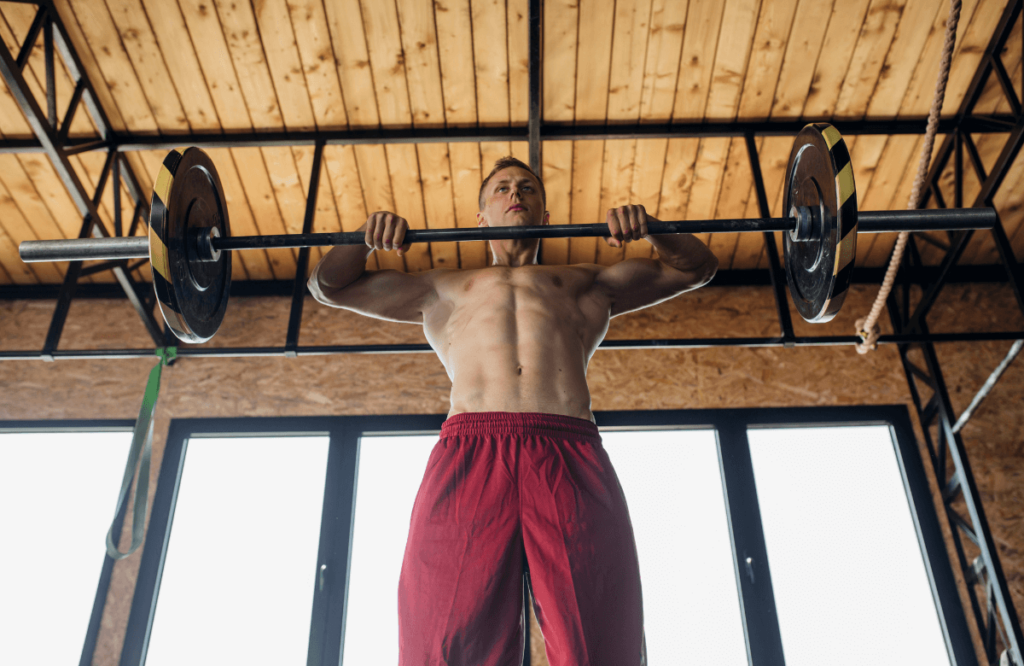
The Risks of Upright Rows
The upright row can have a bad reputation as a dangerous exercise, depending on the conversation. The movement isn’t without risks; common variations can cause injury risks to the shoulder joint, especially over long periods of time.
The standard upright row uses an EZ curl bar or barbell positioned at the hips with a narrow grip. The movement requires you to pull the weight toward the neck, lifting the elbows as high as you can.
Elbows above shoulder height can tug on the shoulder joint, also known as internal rotation. Essentially, internal rotation increases the chance of the bones, tendons, and soft tissue rubbing together, increasing the risk of injury.
Injury concerns are more abundant if you’re using heavy weights and bad form.
Adjusting your technique to stop at shoulder height, using moderate weights, and switching to a pair of dumbbells can reduce the risks of the upright row. That said, it will be up to you to decide if this movement suits your workout regimen.
If you’re unsure or have a previous injury, it’s wise to consult a personal trainer or healthcare professional.
How to Perform the Upright Row
So, how do you perform the upright row while avoiding common mistakes? First, using the dumbbell variation will allow you to keep a tight core and allow your shoulders to move freely, avoiding internal rotation.
Second, it’s best to use light dumbbells. Lighter weights will help you maintain a controlled movement throughout the entire range of motion. Third, ensure your elbows don’t extend past your shoulders, stopping right below shoulder level.
Finally, use comfortable weights in the 8-15 rep range. Heavier weights increase the risk of injury, strain, and internal rotation.
1. Starting Position
First, stand upright with your feet shoulder-width apart. Keep your feet planted firmly on the ground with a slight bend in the knees.
Use an overhand grip to grab the dumbbells. Use a shoulder-width grip with the palms facing the body.
2. Tighten Your Core
Now that you’re in the starting position take a deep breath in to brace your core. Squeeze your glutes to get ready to lift the weight.
3. Lift the Weight
Now, slowly raise the dumbbells straight up toward the chest. Once the elbows are just below shoulder level, squeeze the shoulder blades together.
4. Lower the Weight to Complete
Now, slowly lower the weight back to the starting position to finish one repetition. Repeat the movement for your desired rep range, or 8-15 reps for three sets.
Upright Row Variations
We covered the dumbbell upright row, but there are several variations to consider. Each exercise has advantages, disadvantages, and best-use cases.
Barbell Upright Row
The barbell upright row is the traditional method for performing the exercise. This variation uses a straight barbell or EZ curl bar. Although there are advantages to dumbbells, the barbell technique can be easier for beginners.
Using a barbell can also improve your barbell coordination and mechanics, which can carry over to other lifts. This may be particularly useful if you compete in powerlifting, strongman, or CrossFit competitions.
Single-Arm Upright Row
The single-arm upright row is a unilateral variation and is typically performed with dumbbells. Unilateral movements target one side of the body at a time, allowing you to focus on form and reduce muscle imbalances.
Unilateral movements are useful to incorporate into your training regimen, as they offer an isolation exercise, can improve stability, reduce asymmetries, and carry over to daily tasks and athletics.
Cable Upright Row
The cable upright row requires a cable machine and can be performed as a single-arm variation if you see fit. Cable machines offer a unique benefit, as they provide consistent tension throughout the entire range of motion.
The additional tension challenges the muscles without excessive weight. This recruits a larger amount of muscle fibers, helping you develop more muscle mass.
Upright Row Alternatives
So, maybe the risks of the upright row don’t seem worth it, or you have pre-existing injuries—what alternative exercises can you incorporate into your training regimen to target the same muscles?
There are several movements that use similar muscles. The exercises you select should target the following muscle groups:
- The front, middle, and rear delts.
- The traps
- The rhomboids
Let’s take a look at some upright row alternatives to consider for your custom workout routine.
Barbell Row
The conventional barbell row engages similar muscles as the upright variation but from a different angle. The barbell row requires you to hinge at the hips, allowing you to engage the lat muscles. The exercise also engages the following muscle groups:
The biceps, lower back, and other muscles work as support. The barbell row can be performed using heavy weights for lower reps or lighter weights for more reps. It’s an excellent exercise if your goal is to build a bigger back.
Lateral Raises
If wider shoulders are your primary concern, you should consider adding lateral raises to your routine. Lateral raises are an isolation exercise targeting the lateral deltoids. The movement can be performed with dumbbells, kettlebells, cables, and resistance bands.
It’s best to use lighter weights for higher rep ranges around 10–15. Although this exercise isn’t a complete mass builder, it’s a great accessory movement for developing the shoulders.
Cable Face Pull
The cable face-pull is a fantastic alternative to the upright row, as it targets similar muscles and places less stress on the shoulder joints. Utilizing a cable machine and pulling the weight towards your face promotes a more natural movement pattern, reducing the risk of shoulder impingement and excessive strain.
This makes it an excellent choice for individuals with shoulder issues or those seeking shoulder-friendly exercise. Additionally, the face-pull engages the rhomboids, traps, and rotator cuff muscles, promoting improved posture, shoulder stability, and upper back strength.
Mistakes to Avoid
As mentioned earlier, the upright row can come with more risks than other exercises. You can avoid a few common mistakes and pitfalls to ensure you get the most out of your training session.
Using Too Much Weight
It’s tempting to load the barbell with heavy weights, similar to how you would for the conventional barbell row. Unfortunately, excessive weight can lead to injury or strain.
The shoulder joint can be in a compromised position during the upright row, so less weight is better. Using lighter weights, you can lift comfortably for 8–15 reps is best. Don’t go overboard and prioritize good form above all else.
Lifting the Elbows Above Shoulder Height
Many lifters raise their elbows as high as possible when performing the upright row. This can be dangerous if the elbows extend past shoulder height. Once the elbows go above the shoulders, internal rotation is more likely to happen, increasing the chance of injury.
Instead, stop your elbows just below shoulder height. Doing so will place more tension on the lateral deltoid, turning it into an even more effective shoulder workout.
Frequently Asked Questions (FAQ)
Is the Upright Row Good or Bad?
The upright row can have a bad reputation, depending on who you ask. The main problem is that the movement has a high risk of shoulder impingement and internal rotation. Using lighter weights and keeping the elbows below shoulder height can mitigate these issues.
Why Avoid Upright Rows?
It may be best to avoid upright rows if you have pre-existing shoulder or neck injuries. The additional stress from the exercise can exacerbate pre-existing conditions. If you’re overly cautious, skipping out on this movement for something with an easier movement pattern may be wise.
What Muscles Does the Upright Row Work?
The upright row primarily targets the shoulders and upper back. It’s a compound lift, engaging the traps on the upper and mid back and the deltoids, which wrap around the shoulder muscle. It also targets the rhomboids, biceps, and spinal erectors.















